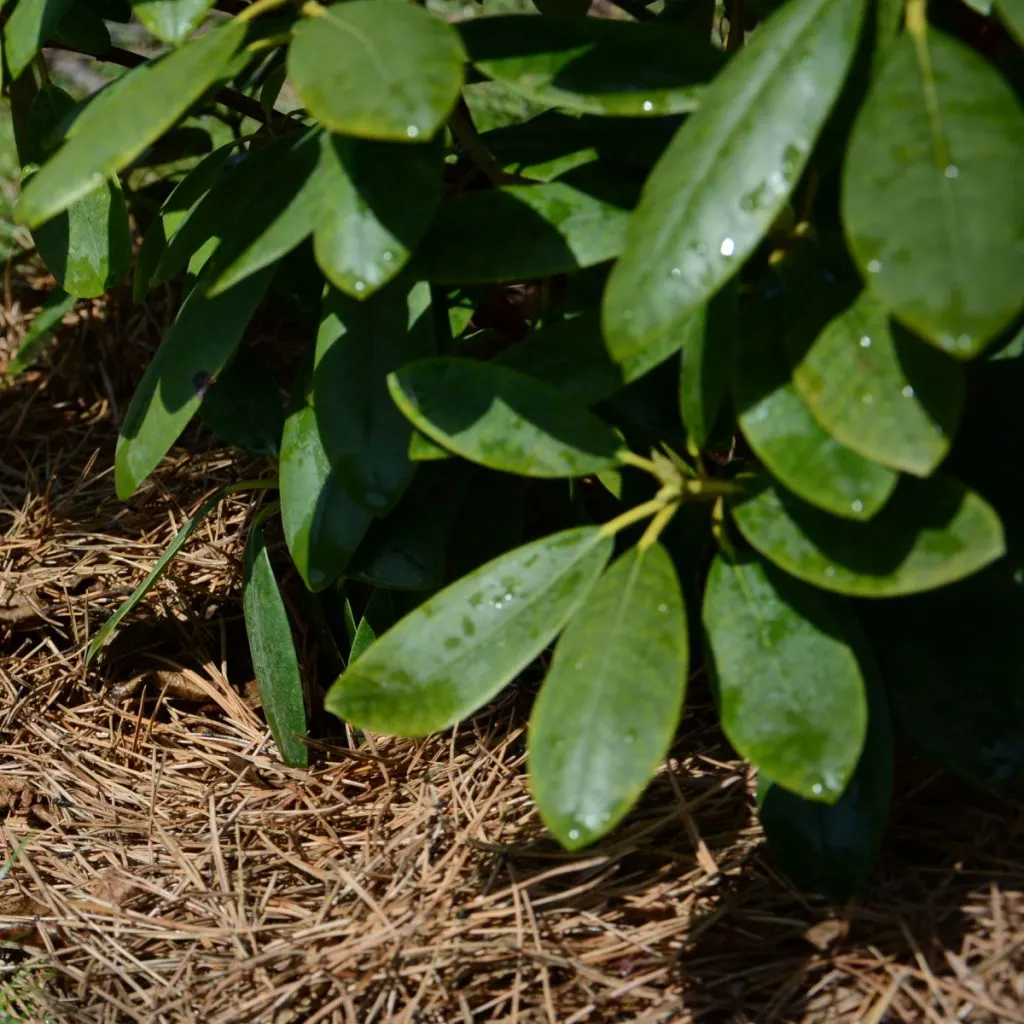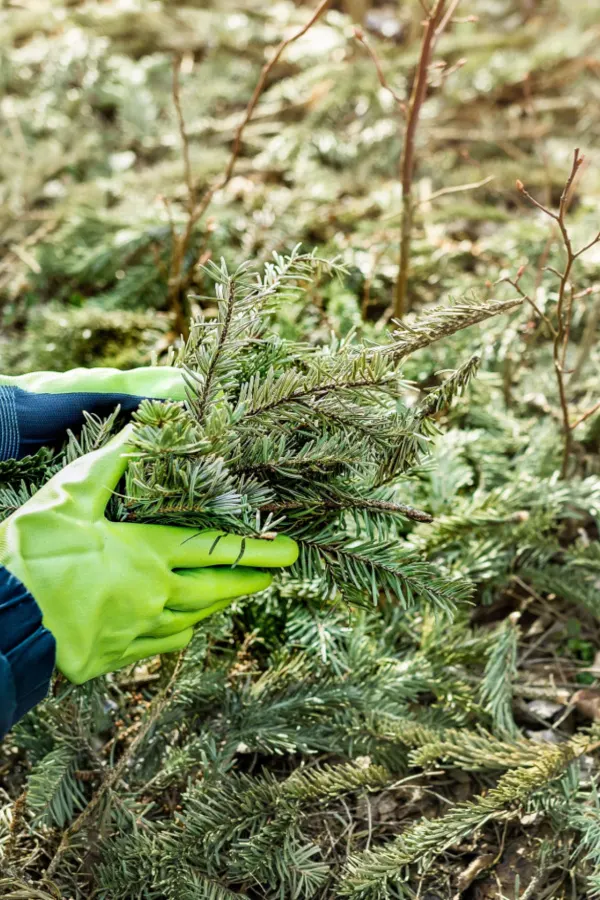Looking for the best way to use all of those pine needles to mulch your acid loving bushes and plants to both protect and power them this fall and winter?
Mulching is crucial when it comes to helping plants survive winter without damage. And that is particularly the case for acid loving plants like azaleas, rhododendrons, blueberries, strawberries, and other perennials that thrive in acidic soils.
Using the right mulch not only helps protect plants from Mother Nature, it also is wonderful for helping to maintain soil moisture and keeping the soil’s temperature more stable through the winter months. Of course, mulch can help to keep weeds out as well. But when it comes to acid loving plants – using pine needles can have all of those benefits – plus help energize the soil around them as well!

Pine needles are an excellent, natural choice for mulching acid-loving plants. They are abundant, sustainable, and have unique benefits that cater specifically to these types of plants. And as you will see below, by simply employing one little trick when you use them – you can really help to power your plants to a better performance next year!
The Best Way to Use Pine Needles To Mulch Acid Loving Bushes & Plants
Why Use Pine Needles for Mulching
Pine needles are excellent for acid loving plants due to their natural properties – the first and most important of which is their acidic nature.
Pine needles have a naturally acidic pH, which makes them ideal for plants that require acidic soil conditions within a 4.5 to 6.0 pH range. As pine needles decompose, they slowly release acidity into the soil, helping to lower or maintain the correct pH.
In addition to the lower acidity range, they are also extremely lightweight and airy – and that has some big benefits for plants. Unlike heavy mulches, pine needles allow air to circulate. This improves soil aeration and prevents soil compaction. This is especially important for the shallow root systems of plants like rhododendrons, azaleas and camellias.
But the benefits don’t stop there, pine needles also are slow to decompose. Much more slowly than other organic mulches like straw or grass clippings. That, of course, means you won’t need to replenish the mulch as often, saving time and money in the process.

How to Use Pine Needles To Mulch Acid Loving Bushes & Plants
Now that we’ve established why pine needles are a great mulch for acid loving plants, let’s dive into how to use them effectively. As it turns out, it’s actually best to use a bit of fresh pine along with dry pine needles when mulching. Why? Because fresh needles actually have more acidity to give back!
Fresh, green needles provide a more instant boost of acid as they break down into the soil. Dryer needles on the other hand do add acidity, but have already lost some acidity due to dying off. They instead provide a more low and slow release as they break down.
Dry needles can simply be raked off the ground – but for fresh, just simply cut a few smaller stems or branches right from the tree for use.
Before applying pine needles in flowerbeds or around plants, always start by removing any existing weeds from the soil. It’s also best to water the soil thoroughly before mulching. This will help lock in moisture for the plant heading into the winter season.
Listen In Below To Our Latest Podcast!

Layering The Needles – The Best Way to Use Pine Needles To Mulch Acid Loving Bushes & Plants
Start by laying down a 1-2 inch layer of fresh pine needles around the base of your plants. The fresh needles release more acidity into the soil as they decompose. This is exactly why it’s best to have them at the soil level for faster activity.
Once you have fresh needles down, then top off with a 3 to 4 inch layer of dry pine needles. This layer provides insulation, reduces weed growth, and slowly breaks down over time to enrich the soil.
While pine needles break down slowly, they will eventually decompose. Because of this, you will most likely have to top off each year. Check the mulch layer each spring and fall, adding a fresh layer of needles to maintain a 3-4 inch thickness.
One final note when mulching, it’s always best to keep the mulch a few inches away from the main base of any plant or bush. This will help to prevent moisture buildup right at the main stem or root. Unfortunately, too much moisture there can lead to root rot and fungal issues.

Now that we have covered how to mulch with pine needles, here is a look at the plants that will benefit most from a protective coat of pine needles:
Acid Loving Plants To Mulch With Pine Needles
- Azaleas and Rhododendrons: These popular flowering shrubs require acidic soil to bloom profusely. Mulching with pine needles not only maintains soil acidity but also provides insulation for their shallow roots.
- Blueberries: Blueberry bushes need a pH between 4.5 and 5.5 for optimal growth. Mulching with pine needles helps maintain the correct acidity while keeping the soil moist.
- Strawberries: These perennials also prefer slightly acidic soil. Pine needle mulch also helps prevent rot by keeping berries off the ground, while also conserving moisture.
- Camellias, Hydrangeas, and Gardenias: These acid loving ornamental bushes benefit greatly from the moisture retention and acidity provided by pine needles.
- Thyme and Oregano: Although most herbs prefer neutral to slightly alkaline soil, certain thyme and oregano actually thrive with the slight acidity boost provided by pine needle mulch.
For more info on using pine needles in other areas of your landscape, be sure to check out our article: The Best Ways To Use Pine Needles In Your Flowerbeds & Garden – How To Use All Of Those Pine Needles!
Here is to using pine needles to mulch your acid loving bushes and plants this fall and winter. And to protecting and powering them at the same time!
This Is My Garden
Follow Our Facebook Page For Great Gardening Tips And Advice! This Is My Garden Facebook Page
This Is My Garden is a garden website created by gardeners, for gardeners. Jim and Mary Competti have been writing gardening, DIY and recipe articles and books and speaking for over 15 years from their 46 acre Ohio farm. They publish three articles every week, 52 weeks a year. Sign up today to follow via email, or follow along!
